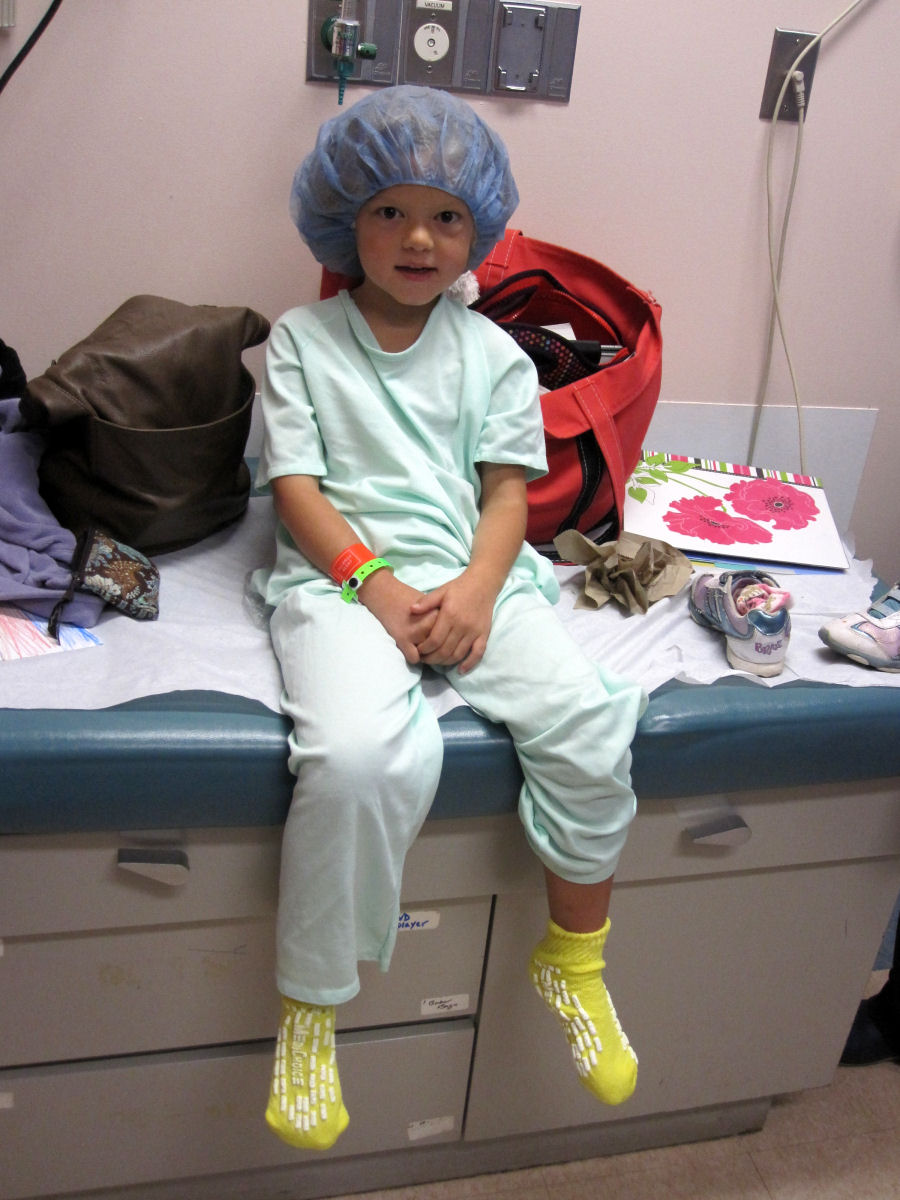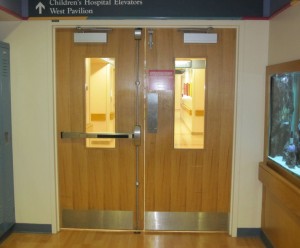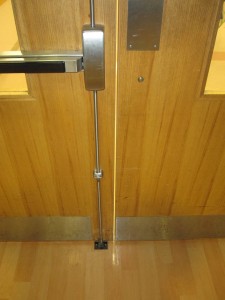I have been amazed and touched by the number of people who actually read my Good News/Bad News post all the way to the end and took the time to call or email me about my daughter’s surgery. Thank you so much for your care and concern. It has been a tough week and an extremely stressful day, but everything went perfectly and my daughter is doing really well. We’re still in the hospital but we hope to be able to go home tomorrow (actually today since it’s 2 a.m.).
As a reward for your patience with my irregular posting, I took some photos of the entry to the surgical suite this morning. All of the specwriters that I know are very meticulous, and spend a lot of time considering how each opening will be used and what the most appropriate hardware would be. So I don’ t know how doors end up like this pair.
We were the first surgery scheduled today, and when we arrived, the surgical staff was also arriving. I approached this pair and tried the lever, which was locked. We wandered down the hall until we found a staff member. She escorted us to these doors, grabbed the pull, and in we went. High security, no, but it probably keeps people out most of the time.
These doors have a panic on one leaf with no bottom latch (the bottom rod is there), and the other leaf has one surface bolt. The outside has, as you can see, one lever and one pull. It looks terrible, it’s not secure, and the panic doesn’t function properly. How does this happen??
You need to login or register to bookmark/favorite this content.










Cute child, who does she take after??? Neat Halloween costume. Glad to hear things went great. Yes with all the inspections a hospital gets sad to see that. It was a hospital and not a day surgery center???
Hi, concerning latching hardware for a surgical suite, I could not locate any exceptions to the positive latching requirements in the building codes concerning an operating room.
From an infection control standpoint, the doctor having to handle a lever after scrubbing up would not be desirable.
The operating room is positive pressure.
Since the doors swing into the room, the positive pressure keeps the doors in a closed position full time.
Are variances typically required for these situations?
Would this present a problem for JCAHO?
Thank you
Hi Robert –
I asked Brad Keyes of Keyes Life Safety Compliance (keyeslifesafety.com) what he thought about this question. He told me that if the door is inside of a suite, it probably doesn’t need a rating. If the door opens onto a corridor (not in a suite), it will require a rating and a positive latch. Neither of us knows of an exception for positive latching in this situation if the rating is required.
Here is some information from Brad regarding suites:
“The advantage of a suite is there are no requirements for corridors inside the suite because it is a room. Therefore, what looks like a corridor is actually an aisle and only minimum widths pertaining to aisles (see section 7.3.4.1) are required to be maintained (28” for existing and 36” for new). That means the restrictions about storing stuff (such as medical equipment and non-combustible supplies) in the corridors no longer applies. Also (and this is a big advantage), since there are no corridors, there are no requirements for corridor doors, which means if there are doors to the inner-rooms (other than doors to exits or hazardous rooms), they do not have to latch. This is huge for those high-acuity areas such as ERs and ICUs where staff needs to have access to the patients quickly.
There is a downside to suites (there always is a downside to things…) in that there are size restrictions, maximum travel distances to exit access corridors, number of exits from the suite, and the path of egress through a suite. Architects sometimes design suites incorrectly. They frequently are either over-sized (which contributes to travel distance problems) or they designate a path of egress into and through a suite. Also, the boundary perimeter of the suite must meet corridor requirements, which means the entrance doors to a suite must latch.”
If you determine that your doors open onto a corridor and require a rating, you may want to consider an auto operator, or electric latch retraction fire exit hardware which would hold the latches retracted until there was a fire alarm. For single doors, a hospital latch would provide latching but does not require the staff to touch the hardware with their hands to operate it.
Regarding variances…the Joint Commission might approve an equivalency for the lack of positive latching hardware, but I’m not sure what the grounds would be since there are ways to overcome the infection control problem.
Dear Lori,
One of mu client who is a consultant doing a Big Hospital job is looking for a complete door hardware solution for ICU / CCU / Operation Rooms. Can you help me with this.
Regard’s
Maharoof
Hi Maharoof –
I don’t have a lot of experience with doors like that, so I don’t feel comfortable recommending a particular product. I’m sorry about that.
– Lori